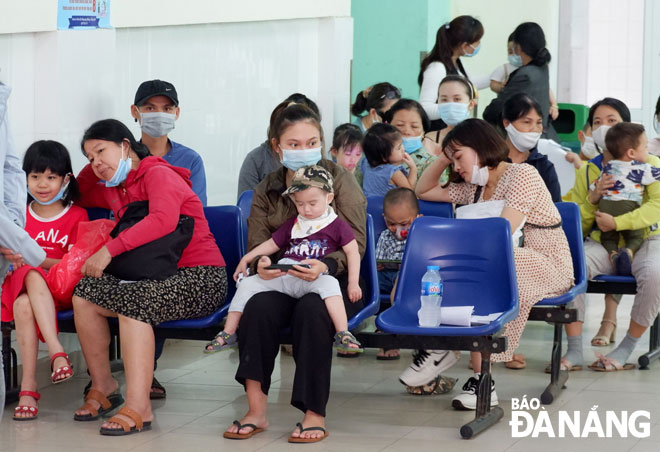Number of child patients catching hand-foot- mouth disease on rise
Over the past week, the number of children catching hand-foot-mouth disease (HFMD) has been on an upward trend in Da Nang. Although there has not been an outbreak like many other localities across the country, local healthcare experts recommend that parents be proactive, and especially comply with preventive measures to protect their children from the disease.
 |
| Parents should comply with preventive measures to protect their children from the disease. |
On 2 April, 51 out of 100 children admitted to the city’s Maternity and Paediatrics Hospital were diagnosed with HFMD.
A 35- month-old boy, residing in Tien Phuoc District, Quang Nam Province, for example, was rushed to the Maternity and Paediatrics Hospital on March 30 with blisters growing around his mouth, palms of hands, plus a high fever. In addition to suffering from HFMD, he had pneumonia, which made his health worse and forced doctors to put him on mechanical ventilation.
Doctor Nguyen Hai Thinh, Head of the Tropical Medicine Ward at the Maternity and Paediatrics Hospital said, among the pediatric patients hospitalised due to HFMD, many come from the nearby central provinces of Quang Nam and Quang Ngai provinces.
It was concerning that some patients received respiratory resuscitation measures due to serious complications. Others suffered from meningitis and acute pulmonary edema as a result of their late hospitalisation.
“HFMD is not a reportable disease, making it difficult for doctors to track. The disease is most common in children ages 5 and younger. Especially, children aged between 1-3 face the high risk of this contagious infectious disease. The rash takes form as spots or bumps on the hands or feet, or lesions of the mouth, but signs can appear elsewhere on the body. Additional symptoms include fever and a sore throat. This disease progresses rapidly every hour, so it is very dangerous to the health and life of child patients” Dr Thinh warned.
Doctor Ton That Thanh, the Director of Centre for Disease Control (CDC) said, since the end of March, his agency has set up some mobile teams tasking themselves for giving a well-timed help to local medical stations if necessary. Besides, heed has been paid to providing sufficient supplies of medicines, medical equipment and chemicals in a great to tackle the upward trend of the HFMD spread.
Outbreaks of the disease, which is a contagious viral illness, can occur all year round, but they especially occur between March and April and between September and November. HFM outbreaks most commonly occur after the end of summer. The hot weather and the accompanying high humidity facilitate the development of both the viruses and the bacteria which are known to directly cause the disease.
Children can get HFMD at all ages but children below 3 years are more susceptible, as they have not developed immunity against the virus.
The incubation period of HFMD is generally between three to seven days. Initial symptoms are fever, loss of appetite, fatigue and sore throat. Sores will form in the mouth, and/or on the hands, feet, knees, elbows, buttocks, and sometimes the genitals.
Sores may look like small spots, bumps or blisters. Sores in the mouth can make eating and swallowing quite painful and consequently your child may refuse to eat and drink. First flat red or scaly patches will appear on the skin, which then develop into non-itchy blisters and will remain for about seven days.
HFMD is usually mild and children will recover spontaneously after seven to 10 days. Sometimes the disease can last a bit longer but severe complications are rare. Mouth sores may cause children to refuse to eat and drink, resulting in dehydration, fatigue and low blood sugar. If that is the case the child needs to be admitted to the hospital to receive fluids and food intravenously (through a tube directly into the blood stream).
HFMD spreads through close contact, coughing and sneezing, or touching objects and surfaces that have been contaminated with the virus.
There are no vaccines against HFMD but some preventative measures may reduce a risk of catching it. Parents should wash their hands often with soap and water for 20 seconds, especially before cooking and feeding their children, and after changing diapers, as well as encourage their children do the same. The intention is to reduce the risk of getting infected with HFMD.
Reporting by PHAN CHUNG- Translating by A.T